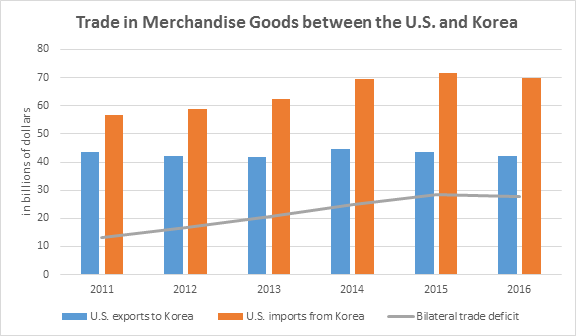The Peninsula
What Does New Trade Data Portend for U.S.-Korea Trade Relations?

By Phil Eskeland
Earlier today, the Foreign Trade Division of the U.S. Census Bureau released the latest statistics on U.S. international trade data. While the overall U.S. trade deficit in merchandise goods with the world increased by $1.9 billion or 0.4 percent, the bilateral trade deficit between the U.S. and South Korea declined by $647 million or 2.3 percent. This decline was a result of a disproportional decline of the value of Korean imports into the United States. For the United States, American exports to Korea surged in December, reaching a record level of $4.3 billion for 2016, despite the rising value of the U.S. dollar, while Korean imports into the U.S. declined to $5.47 billion in December, a decrease from the $5.8 billion value in November.
As a result, the U.S. may be turning a corner with respect to the rising bilateral trade deficit between the U.S. and the Republic of Korea (ROK). The chart below shows the trend in goods trade between the U.S. and Korea since the year before the Korea-U.S. Free Trade Agreement (KORUS FTA) was implemented. More data will be made available next month when the 2016 4th Quarter statistics on services trade will be released. Historically, the U.S. has always generated a trade surplus in services trade with Korea, and therefore the overall bilateral trade deficit for 2016 between the U.S. and Korea may be even less. Only time will tell if this is just a one year respite from the trend in recent years or if this is a foreshadowing of a new development in U.S.-Korea trade relations.
Source: Foreign Trade Division, U.S. Census Bureau
Thus, while there is good news with respect to the merchandise trade deficit between the U.S. and Korea, the economic relationship between the U.S. and Korea is more than just the value of imports and exports with the trade balance figure as the sole determinant as a measure success or failure. As mentioned in previous blog posts, there are now over 350,000 U.S. workers dependent upon exports to Korea (a 24 percent increase or 87,000 new jobs since 2009); Korea has more than doubled its investment in the United States since 2011 and is now the fifth fastest-growing source of Foreign Direct Investment (FDI) into America, employing 45,100 U.S. workers, (up 22 percent or 10,000 new jobs since 2011); and the average annual compensation of U.S. workers employed in firms with investment from Korea have increased 11 percent from 2011 to reach $92,000. Thus, as the Trump Administration deals with trade, it is critical to remember that nearly 400,000 U.S. workers directly owe their employment to Korea trade and investment in America.
Phil Eskeland is Executive Director for Operations and Policy at the Korea Economic Institute of America. The views expressed here are his own.
Photo from Wilson Hui’s photostream on flickr Creative Commons.
